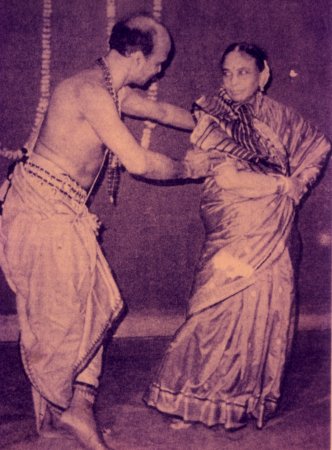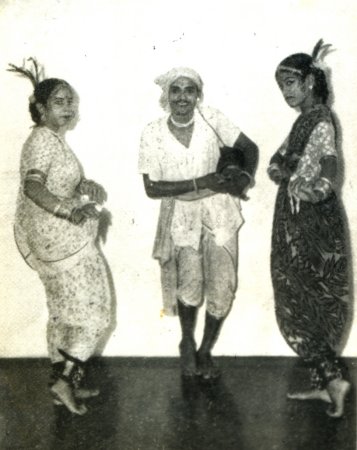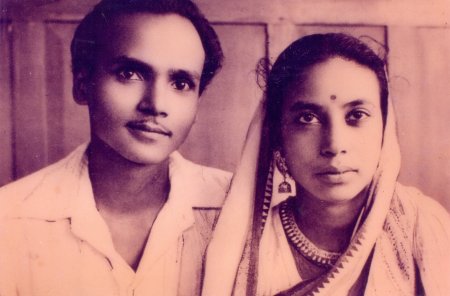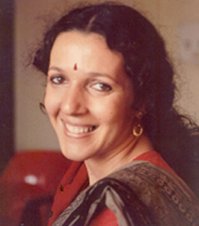 |
  |
 |
  |
Laxmipriya Mohapatra, the first Odissi dancer on stage - Ileana Citaristi e-mail: ileana5@hotmail.com Photos courtesy: Ileana Citaristi March 24, 2021 In the early Forties at the time when female acting or dancing was considered taboo in the society and an occupation akin to prostitution, Laxmipriya became part of the first batch of female dancers to be associated with the Annapurna 'A' group at Puri. Although born at Khurda, she had come to live in Puri with her mother Tulasi Devi at a very early age. She was the youngest one among the first batch of female dancers along with Heera, daughter of a devadasi of Puri, and Nirmala who had left behind the rest of the family in Calcutta, and at the age of seven, had settled down at Puri with her mother. Among the elder ones who were already married at the time of joining the Theatre, were Radharani, Haramani, Balamani, Sara, Ratna and Buddhi. Some had already had a kind of stage experience by having participated either in folk dramas in their respective villages or having been cast by Mohan Sunder Dev Goswami in his film Sita Bibaho. After joining the Theatre, they were left completely under the care of the manager Bauribandhu Mohanty, who would treat all of them like adopted daughters. Slowly, besides dancing, they started to replace the male actors in the female roles and to grow as full fledged artists. By the time Lingaraj Nanda, the manager of Annapurna 'B' group of Cuttack, went to fetch her for the 'B' group, Laxmipriya was around 17 years old and had already acted as Madhavi, the main heroine, in the drama PWD (Public Worst Department) and appeared in few solo dance numbers, besides the group ones. One of the group items danced by Laxmipriya, Sara and Haramani, had been composed by Kashinath Saho in a style akin to the Manipuri one to the accompanying Odia song Manara kotha kohibi kahara sakhi re ('to whom shall I tell the secrets of my heart, oh friend?'). As solo number, she used to perform the song Nila Jamuna kule Kalia ('Krishna on the bank of the blue Jamuna') composed in folk style by Laxminarayan Patra. Her stage presence and aptitude for dance which had already been evident on the 'A' group platform, came to public notice on the occasion of her dance for the 'B' group; she literally mesmerised the audience and earned for herself and the dance which she performed immense admiration. It was her dance which was to inspire in the following years, the first batch of girls who came forward to learn Odissi dance in spite of the social ostracism. The first play in which she participated as a dancer in the B group was the nataka Devi written by Ramachandra Mishra and directed by Samuel Saho (Babi). There was scope for a short dance composition to be inserted in the beginning of the nataka based on the mythological story of the victory of Mohini over the demon Bhasmasura, which required 3 main characters, one female and two males. Pankaj Charan Das who was at that time the dance master of the 'B' group, assigned the role of Mahadev to Kelucharan Mohapatra and kept for himself that of Bhasmasura, Laxmipriya was immediately selected for the role of the temptress Mohini and in about seven days, the fifteen minutes dance-drama was ready to be shown to the manager for approval.  An impromptu demonstration of 'Nahi ki karidela' at Padatik in 1983 After the success of this venture, Lingaraj Nanda called from Banupur, a gotipua master named Krishna Chandra Mohapatra, who taught Laxmipriya two Odia songs, Janare mo rana parama mita (' my dear friend, this is my promise') and Nahi ki karidela ( 'the one who denied'). Both the lyrics were by Kishor Kavi Shyam Sundar Das and put to music respectively by Balakrishna Das and Singhari Shyam Sundar Kar. Laxmipriya got an opportunity to present on stage the second of the two songs in the next play itself, Abhisek written by Aswini Kumar Ghosh. The script centred around the coronation of Kapilendra Dev, the king of Puri, and the dance scene took place before the commencement of the actual drama. The accompaniment on mardala was provided by Kelucharan Mohapatra. The effect on the audience was stunning; people had never imagined that such graceful dance existed and could be presented by a female dancer on the stage since the only dance people used to watch till then, was the one performed by the young boys, the gotipua inside the mathas during religious functions or on open air stages during jatra performances and public festivals. After her personal success in the play Abhisek, Laxmipriya was cast as the main heroine in the next nataka Feriah (The return), a socio-political play written by Gopal Chhottray and directed by Samuel Saho (Babi). The play premiered on the 9th of August 1946 ran full-house up to the month of December of the same year, and turned out to be one of the most successful presentations of the 'B' group. By this time, preparations were on for the next drama to be staged; the script chosen, Sadhava Jhia (The merchant's daughter), was written by Dr. Adwaita Charan Mohanty and the team of directors of the 'B' group assembled along with the writer to discuss about the plot. Lingaraj Nanda was keen on having a dance piece inserted in the play, and Durlav Chandra Singh, the director of the play, suggested that the dashavatar (Ten incarnations) of Lord Vishnu from Jayadeva's Geeta Govinda be composed for the purpose. What emerged was a result of the combined effort of more than one person, each of them contributing in his own capacity to make what later was to be labelled as a historical event in the evolution of Odissi dance. On the rhythmic score set by Durlav Chandra, Hariharan Rout and Kelucharan, Pankaj Charan Das composed the dance sequences, assisted by Lingaraj Nanda and Adwaita Charan Mohanty in understanding the meaning of the Sanskrit shlokas and by Durlav in the choice of the right mudra. The two dancers were Kelucharan and Laxmipriya, the first one taking a dominant role; Kelucharan not only was translating into actions Pankaj Charan's and Durlav's instructions but also teaching them to Laxmipriya and embellishing them with his own insight and sensibility.  Performing Khela-kheluni with Kelucharan and Jayanti Ghosh After this, Lingaraj Nanda did not hesitate to entrust Kelucharan Mohapatra with the direction of the dance sequence to be included in the next play Aloka produced by Priyanath Mishra; the piece, danced by Laxmipriya in three different styles - Manipuri, Odissi and Kathak - was the first dance item to be fully composed by Kelucharan, who also accompanied the dance on mardala. It is during this new venture that Kelucharan's and Laxmipriya's romance developed during these years of intense collaboration, finally blossoming into a full fledged relationship. Kelucharan had admired her beauty and talent since he first saw her on the stage of the 'A' group. Since the day she had been brought to Cuttack by Lingaraj Nanda to join the 'B' group, Kelucharan had been at her side, as partner in dance as well as a trusted friend. She found in him the sense of security which she was deprived of since childhood, having been brought up without a proper family. He was somebody whom she could instinctively trust, particularly for the devotion and sincerity he used to display towards anything he would embark upon. For Kelucharan it was a question of total commitment; she was and continued to be until the end, his 'inspiration'. She possessed everything which he was looking for: she was beautiful, had an excellent sense of rhythm, good musical sense, grace, talent and trusted him completely. After a 'secret' marriage on stage sanctified by exchange of garlands and prasad, the union was sanctified a couple of years later in the temple of Lokanath in Puri. After the birth of the first daughter, the duo left the Annapurna 'B' group and after few months spent at Puri, settled down in Cuttack where Kelucharan started to devote himself to the teaching of the Odissi style of dance which in those years was slowly emerging as an independent art form. Laxmipriya was quite in demand, both as a dancer as well as an actress, and for another ten years or so continued to be actively involved with the semi-professional theatre groups which came into being in the early Fifties, as well as with quite a few Odia films. By the early Sixties, after the birth of her second son, she finally gave up dancing and acting and devoted herself to the care of the family and of the increasing number of students who regularly would be hosted in Kelucharan's house. "I never imagined that Odissi would become so popular in the years to come with so many girls wanting to learn it!" she used to tell us. Although she continued to keep in touch with the management of the classes providing food and all the possible comforts to the students who used to live in the house during the intensive workshops, in the later years she would shy away from demonstrating any dance even if requested. The memory of the years when dance was looked down upon and the social ostracism that she had to face never left her. "People used to cross to the other side of the road if any of us happened to cross their path," she would often say to us.  Kelucharan Mohapatra and Laxmipriya She continued to be a strong pillar of support for Kelucharan Mohapatra who would need to have her at his side and hear her opinion during the making of any new composition. The care and affection which Kelucharan used to shower on her and the reciprocal attachment from her side kept on growing with the passing of the years and provided a strong emotional ambience which would embrace the students coming to the house to learn Odissi from all parts of the world. The creativity of Kelucharan's mind would work only if the atmosphere in the house was peaceful and serene; any small umbrage or misunderstanding with her had to be rectified before he was able to proceed. She kept the rhythm of the household running by performing the daily puja, providing food and be attentive to her son's progress in dance, never wanting to remind anybody of her pioneering contribution to the revival of the dance. That seemed to belong to an era which she preferred to forget about. Now that she has gone, the last link with that era has also gone but her contribution is written down in the history of Odissi dance. (Laxmipriya Mohapatra passed away on March 20, 2021 at Bhubaneswar.)  Dr. Ileana Citaristi is an Italian born dancer, who trained under Guru Kelucharan Mohapatra in Odissi and under Guru Hari Nayak in Mayurbhanj Chhau. She founded Art Vision in 1995 in Bhubaneswar. Comments * Thanks for the article. We would never know about the larger than life legend. - Shaan (March 29, 2021) * Thank you for providing the details of compositional credit for the Annapurna A and B dances she performed, the information on the group of female artists she was part of before shifting to Annapurna B and the later context of fully supporting Guruji and Shibu in their artistic growth. - Sharon Lowen (March 28, 2021) * Thank you for this write up... beautifully explained. - Aleena Acharya (March 25, 2021) Post your comments Please provide your name and email id along with your comment. All appropriate comments posted with name and email id in the blog will also be featured in the site. |